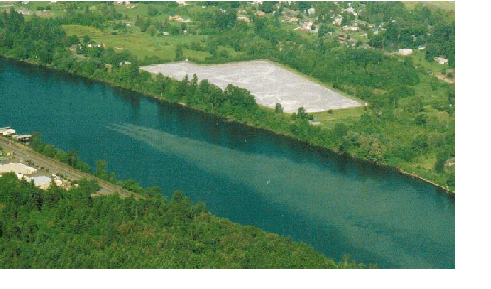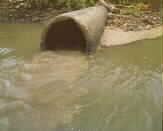

What’s Wrong with Drinking Treated Willamette
River Water?

The West Linn
sewage treatment plant, showing its effluent discharge into the center of the Willamette. This plant is only one of an estimated 85 sewage
facilities discharging sewage effluent into the Willamette.
Why are the
citizens against the Willamette river filter plant? One
reason is the water quality issue. Governor
Kitzhaber’s task force report on the Willamette (as stated in the Oregonian) said
“The Willamette river is sick. Dioxins,
PCB’s sewage, deformed fish, now plague
the river running through the Willamette River Basin.”
Dr. Harold Osterud, Professor and Chairman Emeritus, University of Oregon Health
Science Center, School of Medicine is quoted as saying “Filtration will not remove
toxic products from the breakdown of biological organisms, nor can it remove hazardous
chemicals that inadvertently may pollute the supply”.
The fact is that even the most modern “State of the Art” type of filter
plant will not remove 100% of the contaminants in the water.
A five year study by the
US Geological Survey of 20 major American rivers reported the Willamette among the least
healthy for fish habitat. The report showed 50 kinds of
pesticides in the water, some of which have been suspected of causing severe damage to
human health and wildlife. The most common
pesticide detected was atrazine, which has been banned in 7 European countries and has
been linked to cancer and fertility problems.
The
problem with trying to clean up the Willamette is that most of the pollution comes from
“non point” sources. (70 to 80% according to USGS). More than 4.5 million pounds of pesticides are
used each year in the Willamette basin. The
river flows for hundreds of miles from southern Oregon north to the Columbia. All along its route are hundreds of streams that
flow thru agricultural land picking up pesticides, and thru cattle feed lots and grazing
land picking up bacteria from manure, and then flowing into the Willamette.
Add to this the
estimated 70 sewage treatment facilities and scores of industrial facilities upstream
from the Wilsonville filter plant site which dump their effluent into the
river. And over time the water quality is only getting worse. In
Nov. 1997 OSPIRG reported that over 1.2 million pounds of toxics were legally
discharged into the Willamette in 1994. An April 7, 2000 Oregonian article
stated that the Riverkeepers organization released a study which showed that
"Industries discharged 4.1 million pounds of pollutants in the river in
1997, up from 2 million in '95."
Bill
Preble, a retired Senior Water Quality
Inspector for the Portland Water Bureau, said “There are an estimated 85 sewage
treatment facilities dumping their effluent into the Willamette. In the summer season when water demand is the
highest, 85% of the Willamette river has already been thru a sewage treatment plant.”
There are also the occasional “Combined Sewer Overflows”, and “Sanitary
Sewer Overflows” which dump raw untreated sewage into the river during heavy rains,
and during which period the public is warned to stay away from the Willamette for a few
weeks. This is just the opposite situation
from the Bull Run, with its protected watershed where man, farming and industry are not
allowed. It has been said by experts that
Bull Run water purity is similar to rain water.

Dr. Marvin Hausman, MD, who is
considered an expert on the science of immunological and neurodegenerative diseases, was
recently asked to testify before the Oregon Senate Committee on Natural Resources
regarding the Willamette as a drinking water source.
In his testimony he stated that he is most concerned about heavy metals and
free radicals because of recent evidence that shows a link between these agents and the
occurrence of various diseases such as stroke, Alzheimer’s Disease, heart attack and
liver disease. In the conclusion of his
report he said “The people of the State of Oregon have the right to demand that a
properly funded , well designed scientific study with proper controls be performed and the
results completely analyzed prior to being required to drink potentially toxic Willamette
River Basin water.”
Filter plants use an enormous amount of electricity for pumping the water out of the river, into the plant and then another pump to send it out through the pipes for many miles. According to the 1996 Regional water supply plan, a Willamette river filter plant would have an operating cost six times that of gravity fed Bull Run water. Filter plants also require upgrading, to continue to meet new drinking water standards. In 1996 the Corvalis filter plant was upgraded (at a cost of 11 million dollars) just to maintain the same 21 mgd output it had had before. This ongoing capital cost does not occur with the Bull Run dams. Once they are built, they last hundreds of years.
The City of Wilsonville stated that if they build the treatment plant on the Willamette, when it begins operation in 2002 their average summer residential bill for water alone will be $74.00. This is stated on the city's website - a copy of this page is posted on our website at http://www.hevanet.com/safewater/cost2.htm
![]() WILLAMETTE
TREATMENT PLANT CONSTRUCTION WEB SITE
WILLAMETTE
TREATMENT PLANT CONSTRUCTION WEB SITE
![]() RELIABILITY
OF WATER TREATMENT PLANTS
RELIABILITY
OF WATER TREATMENT PLANTS
![]() OREGONIAN
SERIES OF ARTICLES ON WILLAMETTE RIVER POLLUTION
OREGONIAN
SERIES OF ARTICLES ON WILLAMETTE RIVER POLLUTION